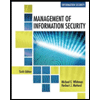
MIS
9th Edition
ISBN: 9781337681919
Author: BIDGOLI
Publisher: Cengage
expand_more
expand_more
format_list_bulleted
Question
Question No 1:
(Topic: Systems for collaboration and social business The
How does Porter's competitive forces model help companies develop competitive strategies using information systems?
• List and describe four competitive strategies enabled by information systems that firms can pursue.
• Describe how information systems can support each of these competitive strategies and give examples.
SAVE
AI-Generated Solution
info
AI-generated content may present inaccurate or offensive content that does not represent bartleby’s views.
Unlock instant AI solutions
Tap the button
to generate a solution
to generate a solution
Click the button to generate
a solution
a solution
Knowledge Booster
Similar questions
- Information systems must be implemented in such a manner that they are accepted and work well within the context of an organization and support its fundamental business goals and strategies. Organizations are considered to be ___________ systems, meaning that can affect and are affected by their surrounding environment.arrow_forwardManagers have an essential role to play in the successful implementation and use of information systems—that role changes depending on which type of IS system is being implemented. When considering the role of business managers in working with IS, it is useful to divide information systems into these three types: a. enterprise IS, group IS, and personal IS. b. small and simple, medium and multifaceted, and large and complex. c. operational, tactical, and strategic. d. management support, operational, and enterprise systems.arrow_forwardInitially thought to be cost-effective for only very large companies, enterprise systems are now being implemented in SMEs to reduce costs, improve service, and increase sales revenue. A firms finance and accounting personnel play a dual role in the implementation of such a system: (1) they must ensure a good payback on the investment in information systems and (2) they must also ensure that the system meets the needs of the finance and accounting organization. Identify three or four tasks that the finance and accounting people need to perform to ensure that these two goals are met.arrow_forward
Recommended textbooks for you
 Fundamentals of Information SystemsComputer ScienceISBN:9781337097536Author:Ralph Stair, George ReynoldsPublisher:Cengage Learning
Fundamentals of Information SystemsComputer ScienceISBN:9781337097536Author:Ralph Stair, George ReynoldsPublisher:Cengage Learning Management Of Information SecurityComputer ScienceISBN:9781337405713Author:WHITMAN, Michael.Publisher:Cengage Learning,
Management Of Information SecurityComputer ScienceISBN:9781337405713Author:WHITMAN, Michael.Publisher:Cengage Learning, Principles of Information Systems (MindTap Course...Computer ScienceISBN:9781305971776Author:Ralph Stair, George ReynoldsPublisher:Cengage Learning
Principles of Information Systems (MindTap Course...Computer ScienceISBN:9781305971776Author:Ralph Stair, George ReynoldsPublisher:Cengage Learning Fundamentals of Information SystemsComputer ScienceISBN:9781305082168Author:Ralph Stair, George ReynoldsPublisher:Cengage Learning
Fundamentals of Information SystemsComputer ScienceISBN:9781305082168Author:Ralph Stair, George ReynoldsPublisher:Cengage Learning Principles of Information Systems (MindTap Course...Computer ScienceISBN:9781285867168Author:Ralph Stair, George ReynoldsPublisher:Cengage Learning
Principles of Information Systems (MindTap Course...Computer ScienceISBN:9781285867168Author:Ralph Stair, George ReynoldsPublisher:Cengage Learning


Fundamentals of Information Systems
Computer Science
ISBN:9781337097536
Author:Ralph Stair, George Reynolds
Publisher:Cengage Learning

Management Of Information Security
Computer Science
ISBN:9781337405713
Author:WHITMAN, Michael.
Publisher:Cengage Learning,

Principles of Information Systems (MindTap Course...
Computer Science
ISBN:9781305971776
Author:Ralph Stair, George Reynolds
Publisher:Cengage Learning

Fundamentals of Information Systems
Computer Science
ISBN:9781305082168
Author:Ralph Stair, George Reynolds
Publisher:Cengage Learning

Principles of Information Systems (MindTap Course...
Computer Science
ISBN:9781285867168
Author:Ralph Stair, George Reynolds
Publisher:Cengage Learning